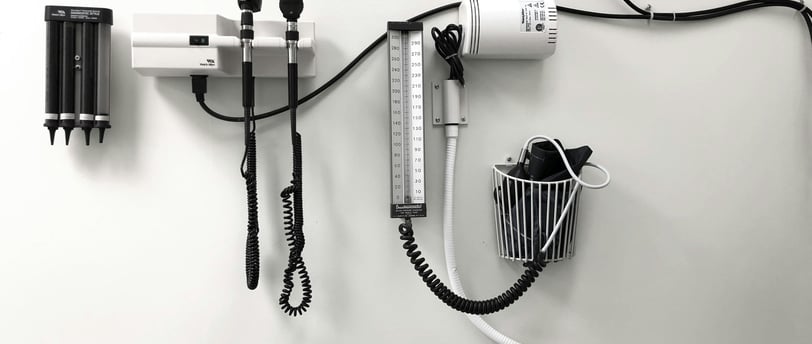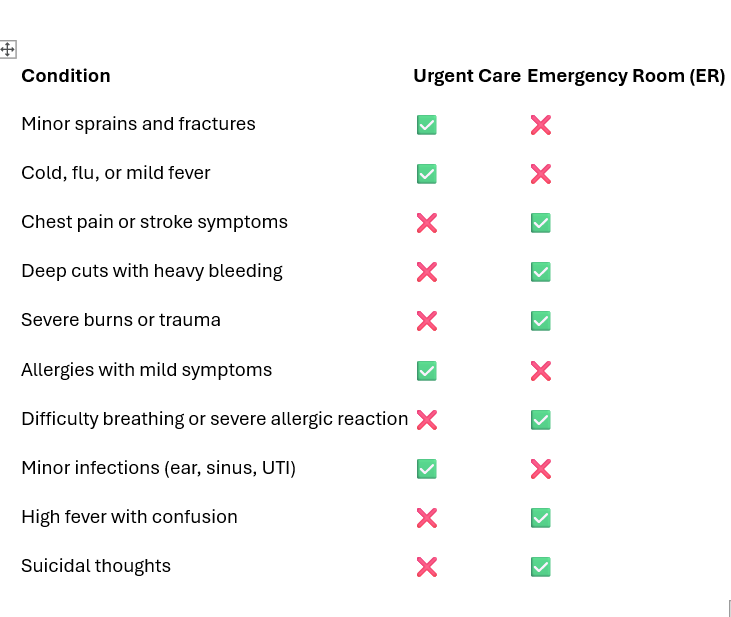Should I go to the emergency room or to urgent care?
Not sure if you should go to quick care or the emergency room? This guide explains the main differences between urgent care centers and emergency rooms, so you can make smart choices based on your symptoms. Know when to go to urgent care for small accidents and sicknesses and when to visit the emergency room for serious health risks. You can also learn about cost differences, wait times, and telemedicine choices to help you save time and money. Save this important tip for later! 🚑💡


When you have a medical concern, you may become confused as to the best place to get care. and may ask yourself if you should quickly visit the urgent care or go to the emergency room (ER). Knowing the difference between the two and when to use each can help you save time, money, and possibly your life.
This guide will help you decide if you should go to urgent care or the emergency room based on your symptoms and how serious they are.
Urgent Care vs. Emergency Room: What’s the Difference?
Immediate medical assistance.
Urgent care centers are for medical issues that need quick help but aren't serious enough to go to the emergency room. These places have longer hours, allow you to walk in without an appointment, and offer faster and cheaper care than emergency rooms.
Emergency Room (ER)
Emergency rooms are for serious health issues that need fast and expert medical help. Emergency rooms are open all day, every day, and have improved tools, specialists, and treatments for urgent care.
When to Visit Urgent Care
Urgent care is a good option if your situation isn’t life-threatening but needs prompt medical treatment. Urgent care often treats common issues such as:
1. Minor Injuries—Sprains and Strains - Small fractures (like in fingers or toes)
- Little cuts that need stitches - Minor burns
2. Mild to Moderate Illnesses—Cold, flu, and fever—Sore throat and strep throat - Ear infections—Sinus infections - Urinary tract infections (UTIs)
3. Skin Problems • Rashes and allergic reactions • Mild burns or sunburns • Small infections • Bug bites and stings
4. Other Health Issues—Vomiting, diarrhea, or mild dehydration - Pink eye (conjunctivitis) - Mild asthma signs - Minor allergic reactions
Main Advantages of Urgent Care:
- Faster service than the emergency room
- Cheaper than emergency rooms - You can walk in without an appointment. - Open longer hours for your convenience
When to Visit the Emergency Room
The ER is for serious, life-threatening conditions that need rapid, advanced medical care. Get medical help if you or someone else has:
1. Serious Injuries and Trauma: Deep cuts that bleed a lot
- Broken bones that stick out of the skin
- Serious burns
- Head injuries where the person loses consciousness
- Gunshot or stab wounds
2. Severe Symptoms that can be Dangerous to Life: - Chest pain or tightness (may mean a heart attack) - Sudden stiffness or weakness (could be a stroke) - Trouble breathing or feeling short of breath
- Seizures or convulsions - Severe allergic reactions causing swelling or breathing problems
3. Serious Illnesses—Intense stomach pain (could be appendicitis), severe vomiting or diarrhea leading to dehydration, high fever along with confusion or seizures, poisoning, or overdose
4. Mental Health Emergencies:
• Suicidal thoughts or attempts
• Severe anxiety or psychosis
Key Benefits of the ER:
• Available 24/7 for emergencies
• Prepared for serious health issues
• Access to specialist doctors and surgeons
• High-tech imaging and testing equipment


• Ability to see expert doctors and surgeons
• Advanced imaging and diagnostic tools
Urgent Care vs. Emergency Room: A Simple Comparison
How much does Urgent Care Cost vs. an emergency room?
Medical prices can be very different between urgent care and the emergency room.
• Urgent care cost: Between $100 and $250.
• Emergency room cost: Between $500 and $3,000+, especially if you get specialized treatments or imaging.
You can decide to visit urgent care for non-emergency cases if you do not have health insurance to help you save a lot of money.
What is telemedicine?
For non-emergency medical issues, telemedicine is a handy and affordable choice. Some health conditions, such as flu, cold, and rash, can be diagnosed and treated virtually with a healthcare provider. But if you are not sure, you can call urgent care and explain your symptoms to them, which can help you decide if you are to visit the ER or not.
• If you are not sure, go to the ER. If there is any risk of a life-threatening emergency, don’t take chances.
• Consider costs and waiting times. If your condition is not severe, urgent care will save time and money.
Conclusion
When you understand the difference between the type of care you can get in urgent care vs the ER, it can make a huge difference in getting the right treatment at the right time. For nonurgent care cases that are not life-threatening, visit the urgent care center. For all medical conditions that require prompt and advanced care, visit the emergency room.
